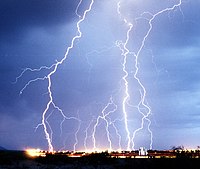
Photo from wikipedia
Biologically-inspired propulsion systems are currently receiving significant interest in the aerospace sector. Since many spacecraft propulsion systems operate at high temperatures, thermal radiation is important as a mode of heat… Click to show full abstract
Biologically-inspired propulsion systems are currently receiving significant interest in the aerospace sector. Since many spacecraft propulsion systems operate at high temperatures, thermal radiation is important as a mode of heat transfer. Motivated by these developments, in the present article, the influence of nonlinear thermal radiation (via the Rosseland diffusion flux model) has been studied on the laminar, incompressible, dissipative EMHD (Electro-magneto-hydrodynamic) peristaltic propulsive flow of a non-Newtonian (Jefferys viscoelastic) dusty fluid containing solid particles through a porous planar channel. The fluid is electrically-conducting and a constant static magnetic field is applied transverse to the flow direction (channel walls). Slip effects are also included. Magnetic induction effects are neglected. The mathematical formulation is based on continuity, momentum and energy equations with appropriate boundary conditions, which are simplified by neglecting the inertial forces and taking the long wavelength and lubrication approximations. The boundary value problem is then rendered non-dimensional with appropriate variables and the resulting system of reduced ordinary differential equations is solved analytically. The impact of various emerging parameters dictating the non-Newtonian propulsive flow i.e. Prandtl number, radiation parameter, Hartmann number, permeability parameter, Eckert number, particle volume fraction, electric field and slip parameter are depicted graphically. Increasing particle volume fraction is observed to suppress temperature magnitudes. Furthermore the computations demonstrate that an increase in particle volume fraction reduces the pumping rate in retrograde pumping region whereas it causes the opposite effect in the co-pumping region. The trapping mechanism is also visualized with the aid of streamline contour plots. Increasing thermal radiation elevates temperatures. Increasing Hartmann (magnetic body force) number decreases the size of the trapping bolus whereas the quantity of the does not effected. Conversely increasing particle volume fraction reduces the magnitude of the trapping bolus whereas the number of trapped bolus remains constant.
Journal Title: Engineering Science and Technology, an International Journal
Year Published: 2017
Link to full text (if available)
Share on Social Media: Sign Up to like & get
recommendations!